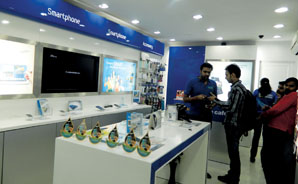Converting browsers to buyers
By Nabamita Chatterjee | May 20, 2013
A TNS 2013 Mobile Life study reveals how high street retailers can turn browsers into buyers. The study shows that whilst 'showrooming' is a very real threat, mobile can offer a solution to brands in minimising this risk.
 Latest research findings released recently by TNS reveal that mobile can play a valuable role in reducing the risk that 'showrooming' poses to retailers. 'Showrooming', where people visit stores only to test products but buy them later elsewhere, has emerged as a significant threat to the high street in recent years, with one third of mobile users globally admitting to 'showrooming' behaviour.
Latest research findings released recently by TNS reveal that mobile can play a valuable role in reducing the risk that 'showrooming' poses to retailers. 'Showrooming', where people visit stores only to test products but buy them later elsewhere, has emerged as a significant threat to the high street in recent years, with one third of mobile users globally admitting to 'showrooming' behaviour.TNS's annual Mobile Life study, based on responses from 38,000 people in 43 countries, shows that whilst 'showrooming' is a very real threat, mobile can offer a solution to brands in minimising this risk. Among those who showroom, two thirds use their phone whilst doing so, providing a major opportunity for brands to interact with consumers via mobile and turn browsers into buyers.
Matthew Froggatt, Chief Development Officer at TNS, said, "The impact of digital development, mobile Internet and online shopping are coming together in a way that is posing a very real threat to traditional bricks and mortar retailers. However, there is also opportunity to mitigate that risk for brands that get their customer engagement right."
Some behaviour - such as using a mobile to conduct independent research in-store - do present risks to retailers, as external influences may increase a shopper's likelihood of leaving without making a purchase. However, the study shows that people are open to engaging with brands whilst in-store, with more than one tenth (11 percent) of smartphone owners in India keen to receive mobile coupons whilst shopping and 14 percent interested in apps that help them navigate the store they are in compared to one fifth of people globally.
Meanwhile 10 percent of consumers in India are interested in a 'virtual sales assistant', compared to 13 percent consumers globally, who will help answer their questions in-store about a particular product. This openness to interacting does present a real opportunity for brands that get their mobile strategy right, to engage meaningfully with people at the point when they are considering a purchase.
Parijat Chakraborty, Executive Director, at TNS India adds, "People in India still want the reassurance of seeing a product before they buy it. Rather than seeing mobile as a threat to in-store sales, brands and retailers must embrace it as the most immediate and personalised way to engage with shoppers while they are in-store to ensure they don't leave empty-handed."
 Showrooming is a global phenomenon, but the role played by mobile varies significantly across the world. In markets where people's first introduction to the Internet has been via a handset, shoppers are highly likely to use their mobile when showrooming - 75 percent in emerging Asia, 87 percent in the Middle East and North Africa and 67 percent in Sub-Saharan Africa. People in developed markets, where online shopping is well established, are less likely to do so, with 55 percent of showroomers in North America and 56 percent in Europe using their phones in this way.
Showrooming is a global phenomenon, but the role played by mobile varies significantly across the world. In markets where people's first introduction to the Internet has been via a handset, shoppers are highly likely to use their mobile when showrooming - 75 percent in emerging Asia, 87 percent in the Middle East and North Africa and 67 percent in Sub-Saharan Africa. People in developed markets, where online shopping is well established, are less likely to do so, with 55 percent of showroomers in North America and 56 percent in Europe using their phones in this way."In developed markets, mobile presents an opportunity to break established showrooming behaviours and make purchasing in retail more appealing. However in emerging markets, where there is a greater tendency to embrace disruptive behaviours, there is an imminent threat of new showrooming behaviour driven by mobile," commented Froggatt.
The biggest drivers for showrooming consumers are twofold: reassurance on price and reassurance on suitability. Reading reviews or checking social media whilst in-store to inform their decision-making stands at 2.4 percent in India compared to 16 percent globally. 42 percent Indian consumes prefer asking friends and family what they would recommend buying. This is in line with 49 percent in emerging Asian markets and much higher when compared to such consumers globally (25 percent).
Having knowledgeable sales staff on hand is no guarantee of success, with two-fifth (39.7 percent) consumers in India preferring to access information on their phone than speak to a sales assistant in store, compared to almost a third of people globally and two-fifths of 16-30 year olds. While people continue to choose diverse ways of seeking the reassurance they require, an integrated approach meeting customer needs at all touchpoints is essential.
Parijat concludes, "The increased popularity of m-commerce is not the death-knell for conventional retailers. Both online and offline retailers need to understand the complex mix of decision making elements in-store and online, and sharpen their strategies accordingly. Consumers want both the formats to exist; however, they wish to see the benefit of both in each. The success for marketers will depend on how the best of both the worlds can be offered by bringing in synergies across online and offline".
Advertisement
Related Viewpoints
Advertisement

_165_265.jpg)
_165_265.jpg)






Comments